How do interest rates impact loans?
Understanding the influence of interest rates on borrowing and lending

interest rates tend to increase during periods of economic growth and inflation
interest rates can be thought of as the "cost of money"
Interest rates often fluctuate based on demand and supply dynamics of credit
The cost of borrowing and the role of interest rates
When it comes to borrowing money, businesses need to account for several costs, including interest rates, discounts, premiums resulting from debt security issuance, loan fees, profits, losses, and other factors that contribute to borrowing costs. The cost of borrowing tends to rise with the increase in market interest rates during periods of economic growth and inflation. Hence, when a country's central bank increases interest rates, borrowing costs typically follow suit.
Understanding interest rates:
The interest rate is a charge imposed by the lender on the borrower, usually a percentage of the principal or borrowed amount. This rate is typically represented on an annual basis, referred to as the Annual Percentage Rate (APR). Essentially, interest is a fee that borrowers pay for the privilege of using the lender's capital. Therefore, the interest rate can be thought of as the "cost of money", as higher rates make borrowing the same amount more expensive. Whether it's for purchasing homes, financing projects, or funding businesses, interest rates apply to most lending or borrowing transactions.
Effects on personal loans and credit cards:
For both personal loans and credit cards, borrowers receive money from lenders at a particular interest rate and then make monthly payments that consist of principal and interest. Irresponsible use of such debt can negatively affect one's credit rating. These two lending forms also have notable differences. For example, personal loans typically have lower interest rates and don't provide continuous access to money like credit cards, especially for those with good to excellent credit.
Factors influencing central banks' rate decisions:
Interest rates often fluctuate based on demand and supply dynamics of credit. Increased demand or reduced supply of credit will likely raise interest rates, while decreased demand or increased supply of credit can lower them. Inflation also impacts interest rate levels: higher inflation rates usually lead to increased interest rates as lenders demand higher returns to compensate for future purchasing power loss of their money. Additionally, the federal funds rate, the rate at which institutions lend to each other over the short term, affects the interest rate banks set for the money they lend, subsequently influencing other short-term lending rates.









